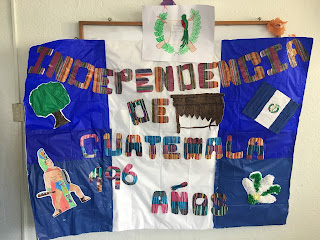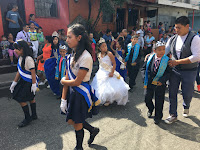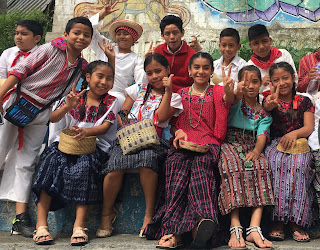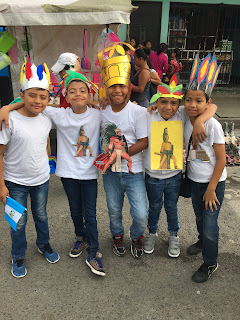Independence Day Celebrations
Independence Day is a day of strong pride and patriotism in many countries, and Guatemala is no exception. Cities adorn their streets with flags or banners and streamers bearing the blue and white colors of the Guatemalan flag. Restaurants and stores likewise decorate their establishments, and many will also have promotions and discounts for the month. Parades with bands take place throughout the day, and firecrackers light the sky at night. All over the country there are celebrations taking place to pay tribute to the day 196 years ago when Guatemala and many other Latin American countries claimed independence from Spain after 300 years of colonial rule.
My school had a variety of events culminating in a cultural week to commemorate the holiday. One of our first events was an acto cívico. Aside from the customary singing of the national anthem and reciting the pledge of allegiance, students from each grade level recited poems about Guatemala.
The next major event we had was the election and coronation of the "Niña y Mister Independencia." Each grade level had one boy and one girl representative to participate in a competition that would select a "Ms. and Mr. Independence" to represent the school. The pageant had four parts; in the first the participants dressed in traditional clothing, introduced themselves and explained what they were wearing.
In the next part the participants donned sports garment and demonstrated a bit of their skill. Aside from the ever popular football, there was a bit of a show of tennis, dance, karate, and even equestrianism.
The third part was the talent section, and we had some very entertaining musical numbers which included singing, dancing, and a belly dancer.
The last part was the Q and A. The participants dressed up in formal wear, and were asked questions related to Guatemala and its independence.
It was a long and busy morning, and all the classes were present to watch and support their classmates.
After the last part, the judges tallied up their scores, and the participants were awarded. Everyone won something; there were small awards such as Niña Talenta (Talent) or Mister Deporte (Sports), and the biggest two were crowned Ms. and Mr. UPAVIM and Ms. and Mr. Independencia. The court would represent UPAVIM in the parades that they would participate in in the coming days.
Rhythmic gymnastics seems to be quite popular in this part of the country. Our school was invited to participate in a small competition among a few schools in Villa Nueva. My fourth graders were chosen to represent the school, and right after the morning's election and coronation, the teachers headed over to cheer them on. They didn't win, but they had a good time nevertheless.
On September 7th, we joined a parade that included many other schools in Villa Nueva. For this parade each grade level of my school dressed up in different clothing of Guatemalan culture. My fourth graders dressed up in the colonial period (strange choice, but I digress).
The sixth graders donned the beautiful traditional Mayan clothing.
My first graders dressed up as Xincas (you can read more about them at the end of this post).
The fifth and second graders came in Mayan and Xinca dress.
Some cute Prepa kids were Garifunas...
...and they were ready to celebrate!
At the head of the parade were some students carrying the school banner and the flag of Guatemala followed by the Misters and Misses who I mentioned earlier.
We were waiting for a long time to start the parade; we were the 11th school in line, and I counted at least two more behind us. After two long hours, we finally started walking and joined in the festive atmosphere of cheers. Several schools also had a marching band, and there was lively music all throughout.
It was fun walking through the streets seeing the houses, stores, and schools decorated, and hearing all the onlookers join in on the cheering.
On the week leading up to Friday, September 15th, our school had its own cultural week, with one event each day. The first was folkloric dances.
Kindergarten kicked the event off with a dance from Santiago, Sacatepéquez. They started off with some traditional dance moves, and also depicted an offering scene.
It was really cute, and you can watch a few clips below.
First grade did a Punta dance, a very lively music and dance style traditional to the Garifunas, which consists of rhythmic chanting and drum beats.
Second grade did an interpretive "Danza del Maíz" (Dance of the Corn) depicting the corn harvest.
The third graders showed us a dance from the town Chichicastenango, a bit similar to what I've heard they dance in the town fiesta.
The next few dances were an interpretive market scene dance by fourth grade, a train dance by fifth, and a pineapple dance by sixth grade. I personally love cultural shows, and was delighted to glimpse a bit of Guatemala's traditional dances.
Tuesday's theme was rhythmic gymnastics, which I previously mentioned seems to be really popular. The performances were nothing very elaborate, but each grade level was creative. They all put on quite a show, and it was entertaining to watch.
On Wednesday we had our second parade, but this time, it was just our school that marched. For this parade, each grade level dressed up as one of Guatemala's national symbols. Kindergarten went as the quetzal, Guatemala's beautiful national bird. It has a blue-green body, and a famous red breast.
First grade was the flag, and dressed up in blue and white. They were also assigned to bring chinchines, which is what they call maracas over here.
The Second graders were the monja blanca, Guatemala's national flower, which symbolizes peace, beauty and art.
Third grade went as the escudo (coat of arms). The escudo has two laurel branches symbolizing victory, the quetzal which is a symbol of liberty, rifles meaning the country's defense, swords which represent the honor of the Guatemalan people, and a scroll which declares Guatemala's independence date.
My fourth graders imitated Tecún Umán, Guatemala's national hero, a Quiché king who faced an army of Spanish conquistadors. Legend goes that after he died, a quetzal flew over and fell on the king's bloodied chest thus staining his own chest, which is why the quetzal is red breasted.
Fifth grade was the ceiba, one of the great tropical trees common in the tropical regions of America. Some sources say that the name Guatemala is derived from an ancient Mayan language which means "land of the trees."
And the sixth graders dressed in traditional wear and had mini marimbas, Guatemala's beloved instrument.
Like before, students carrying a banner and the Guatemalan flag, along with the misters and misses led the parade.
Some of the Pre-Kinder students dressed as Garifunas, and also pictured below are two of my first graders who were some of the flag bearers.
It was a fun and tiring morning of walking almost two hours, but we kept going with the cheers and the support of the community.
The last celebration of the week, and my favorite(!), was all about traditional food. Each student brought in a small dish, and they presented it to the class telling them about the dish, where it is from, the ingredients, and how it is prepared.
Several students brought their food in clay dishes/pots, where stews are traditionally served to help keep them warm, and a few even brought tablecloths with Mayan designs and patterns.
Maybe half of my class brought pepián, a true traditional dish and a favorite, but I did see two dishes I hadn't seen before: mole de plátano (on the left below) and pulique (on the right).
Mole de plátano is sweet dish of plantains served in mole which is chocolate and chili based sauce. Pulique is yet another stew which was described to me as different because it doesn't use any oil, the meats and seasoning are cooked at the same time. Unlike most other stews which are reddish in color, pulique is a vibrant yellow. Its main flavor comes from the herb apazote. It's said to be a true Mayan dish, and originates for Quiche.
More pictures below (plus adorable first graders). Chuchitos, mole and pepián (more on Guatemalan food here and here) --
Mole and more pepián --
Tamales, of course had to be in there --
We ended the activity by eating, and a few students shared their food with me.
One of the things I love about traveling and living abroad is getting to immerse myself in the country's culture. The past few weeks have been a delight, not only getting to partake Guatemala's culture firsthand, but witnessing the love and passion they have for their country.
Happy Independence Day, Guatemala! 🇬🇹









































































































Comments